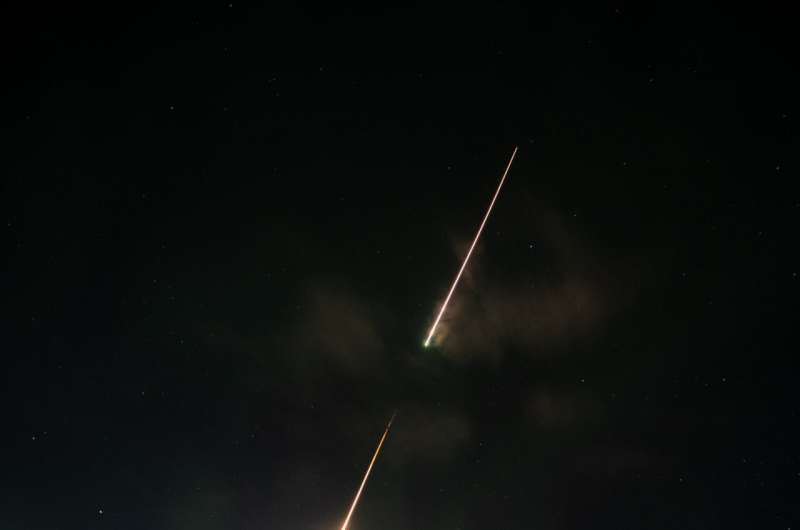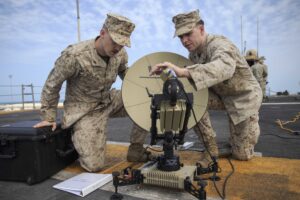Op-ed | Russian threats a reminder of the need to protect GPS
Monday, 07 March 2022 20:00
The space-based navigation capabilities of the United States and its allies remain vulnerable to spoofing, denial and attack
The post Op-ed | Russian threats a reminder of the need to protect GPS appeared first on SpaceNews.
NASA's Psyche gets huge solar arrays for trip to metal-rich asteroid
Monday, 07 March 2022 17:14
With its solar arrays installed, the spacecraft is close to its final configuration ahead of a planned August launch.
NASA's Psyche mission is almost ready for its moment in the Sun—a 1.5-billion-mile (2.4-billion-kilometer) solar-powered journey to a mysterious, metal-rich asteroid of the same name. Twin solar arrays have been attached to the spacecraft body, unfolded lengthwise, and then restowed.
Hubble's Advanced Camera for Surveys celebrates 20 years of discovery
Monday, 07 March 2022 16:27
Today marks the 20th anniversary of the Advanced Camera for Surveys (ACS) aboard the NASA/ESA Hubble Space Telescope. On 7 March 2002 astronauts installed the ACS during Hubble Servicing Mission 3B, also known as STS-109. With its wide field of view, sharp image quality, and high sensitivity, the ACS delivers many of Hubble's most impressive images of deep space.
The ACS wavelength range extends from the ultraviolet, through the visible and out to the near-infrared. Its name, the Advanced Camera for Surveys, comes from its particular ability to map large areas of the sky in great detail. The ACS can also perform spectroscopy with a special optical tool called a grism.
Three subinstruments make up the ACS. The Wide Field Channel is a high-efficiency, wide-field, optical and near-infrared camera that is optimized to hunt for galaxies and galaxy clusters in the remote and ancient Universe, at a time when the cosmos was very young. The High Resolution Channel was designed to take extremely detailed (high resolution) pictures of the light from the centers of galaxies with massive black holes, though this is not currently operational, and the Solar Blind Channel blocks visible light to allow faint ultraviolet radiation to be discerned.
NASA rocket launches from Alaska in search of aurora answers
Monday, 07 March 2022 14:51
A NASA Black Brant IX sounding rocket soared high out of Poker Flat Research Range north of Fairbanks at 2:27 a.m. Saturday to learn more about pulsating aurora.
The Loss through Auroral Microburst Pulsations, or LAMP, experiment seeks to determine whether the pulsating aurora is connected to another phenomenon called microbursts, higher-energy electrons from the Earth's magnetosphere driven toward Earth in bursts that last about one-tenth of a second. That is faster than the pulsating aurora but similar to the flickering inside the pulsations.
A pulsating aurora looks patchy and occurs within minutes or sometimes hours after the conclusion of a discrete aurora, the familiar curtain-like type of aurora.
The launch had been repeatedly postponed since the Feb. 24 opening of the launch window because scientists needed the right combination of active aurora and good weather at a camera site in Venetie, which is located more than 130 miles north of the range.
Weather and aurora activity improved in recent days. Alexa Halford, space physics researcher at NASA's Goddard Space Flight Center and the experiment's lead investigator, detected pulsating aurora over Venetie early Saturday and determined that launch conditions were favorable.
Solar Orbiter crosses the Earth-Sun line as it heads for the Sun
Monday, 07 March 2022 12:00
The ESA/NASA Solar Orbiter spacecraft is speeding towards its historic first close pass of the Sun. On 14 March, the spacecraft will pass the orbit of Mercury, the scorched inner planet of our Solar System, and on 26 March it will reach closest approach to the Sun.
China launches test satellites for broadband constellation
Monday, 07 March 2022 11:04
China launched a set of commercial satellites Saturday for testing broadband services, on-orbit networking and integrating communications and remote sensing technologies.
DoD wants ‘resilient’ space systems, but how to get there is still unclear
Sunday, 06 March 2022 21:40
What it will take to make DoD constellations more resilient and achieve space superiority is still being debated, industry executives said.
The post DoD wants ‘resilient’ space systems, but how to get there is still unclear appeared first on SpaceNews.
Russia stops deliveries of rocket engines to US, Roscosmos Head Says
Sunday, 06 March 2022 08:36 Earlier in the week, Roscosmos head Dmitry Rogozin refuted claims that the Russian space agency had allegedly "lost control" of its satellites, stressing that any cyberattacks against the country's satellites are a "casus belli".
Russia will stop deliveries of rocket engines to the United States, Roscosmos head Dmitry Rogozin announced Thursday.
"Not only are we refusing to supply th
Earlier in the week, Roscosmos head Dmitry Rogozin refuted claims that the Russian space agency had allegedly "lost control" of its satellites, stressing that any cyberattacks against the country's satellites are a "casus belli".
Russia will stop deliveries of rocket engines to the United States, Roscosmos head Dmitry Rogozin announced Thursday.
"Not only are we refusing to supply th Tiangong scheduled for completion this year
Sunday, 06 March 2022 08:36 China's Tiangong space station is scheduled to be completed before the end of this year and will become a massive spacecraft stack with a combined weight of nearly 100 metric tons, according to a program leader.
Zhou Jianping, chief designer of the nation's manned space program, said the assembly phase of the Tiangong program will begin in May and will involve the launch of two astronaut c
China's Tiangong space station is scheduled to be completed before the end of this year and will become a massive spacecraft stack with a combined weight of nearly 100 metric tons, according to a program leader.
Zhou Jianping, chief designer of the nation's manned space program, said the assembly phase of the Tiangong program will begin in May and will involve the launch of two astronaut c Sino-European joint space mission conducts magnetometer extension test
Sunday, 06 March 2022 08:36 A China-Europe joint space mission, Solar Wind Magnetosphere Ionosphere Link Explorer (SMILE), has successfully carried out the extension test of its payload magnetometer in Europe, Science and Technology Daily reported Wednesday.
The test shows that the function and performance of the magnetometer subsystem integrated with the payload module meet the mission requirements and that the rese
A China-Europe joint space mission, Solar Wind Magnetosphere Ionosphere Link Explorer (SMILE), has successfully carried out the extension test of its payload magnetometer in Europe, Science and Technology Daily reported Wednesday.
The test shows that the function and performance of the magnetometer subsystem integrated with the payload module meet the mission requirements and that the rese Integrated Deterrence at Center of Upcoming National Defense Strategy
Sunday, 06 March 2022 08:36 With China, Russia, Iran and North Korea all pursuing advancements in their own nuclear capabilities, and both China and Russia developing advanced hypersonic weaponry and space capabilities, the United States will continue to rely on nuclear weapons as a central part of its own strategic deterrence. But there will need to be more than just nuclear weapons if the U.S. is to maintain its own secu
With China, Russia, Iran and North Korea all pursuing advancements in their own nuclear capabilities, and both China and Russia developing advanced hypersonic weaponry and space capabilities, the United States will continue to rely on nuclear weapons as a central part of its own strategic deterrence. But there will need to be more than just nuclear weapons if the U.S. is to maintain its own secu A River Runs Through It: Onward to the Delta
Sunday, 06 March 2022 08:36 The delta is calling and we must go! With one Earth year in its rearview mirror, the Perseverance rover has been racking up the odometry en route to the site of it's next science campaign. It's been a trip down memory lane since leaving Seitah on Sol 340 (Feb 2, 2022) and retracing our tracks back to the Octavia E. Butler landing site.
Familiar views and rocks greet us like old friends as
The delta is calling and we must go! With one Earth year in its rearview mirror, the Perseverance rover has been racking up the odometry en route to the site of it's next science campaign. It's been a trip down memory lane since leaving Seitah on Sol 340 (Feb 2, 2022) and retracing our tracks back to the Octavia E. Butler landing site.
Familiar views and rocks greet us like old friends as NASA begins assembly of Europa Clipper
Sunday, 06 March 2022 08:36 When it's fully assembled, NASA's Europa Clipper will be as large as an SUV with solar arrays long enough to span a basketball court - all the better to help power the spacecraft during its journey to Jupiter's icy moon Europa. And just about every detail of the spacecraft will have been hand-crafted.
The assembly effort is already underway in clean rooms at the agency's Jet Propulsion Lab
When it's fully assembled, NASA's Europa Clipper will be as large as an SUV with solar arrays long enough to span a basketball court - all the better to help power the spacecraft during its journey to Jupiter's icy moon Europa. And just about every detail of the spacecraft will have been hand-crafted.
The assembly effort is already underway in clean rooms at the agency's Jet Propulsion Lab Sols 3403-3404: Tiptoe to the Pediment
Sunday, 06 March 2022 08:36 The terrain continues to challenge us as we make our way up onto the Greenheugh pediment. Monday's drive ended sooner than expected when the rover sensed the road was rockier than anticipated, so it paused to wait for further instructions from Earth. In the mean time, we took advantage of this brief pause to 'sniff' the rock field all around us.
First, we took ChemCam and Mastcam of "Tobar
The terrain continues to challenge us as we make our way up onto the Greenheugh pediment. Monday's drive ended sooner than expected when the rover sensed the road was rockier than anticipated, so it paused to wait for further instructions from Earth. In the mean time, we took advantage of this brief pause to 'sniff' the rock field all around us.
First, we took ChemCam and Mastcam of "Tobar Selecting the right structural materials for fusion reactors
Sunday, 06 March 2022 08:36 Do two promising structural materials corrode at very high temperatures when in contact with "liquid metal fuel breeders" in fusion reactors? Researchers of Tokyo Tech, YNU and QST now have the answer. This high-temperature compatibility of reactor structural materials with the liquid breeder-a lining around the reactor core that absorbs and traps the high energy neutrons produced in the plasma
Do two promising structural materials corrode at very high temperatures when in contact with "liquid metal fuel breeders" in fusion reactors? Researchers of Tokyo Tech, YNU and QST now have the answer. This high-temperature compatibility of reactor structural materials with the liquid breeder-a lining around the reactor core that absorbs and traps the high energy neutrons produced in the plasma 
